The Duty of Arts & & Crafts Architects in Elevating Architectural Solutions in Residential Style
Arts and Crafts architects considerably affect household layout through their commitment to craftsmanship and sustainability. They prioritize handcrafted details and all-natural products, which boost both aesthetics and neighborhood identification. By entailing customers in the style procedure, these architects produce special space that reverberate with individual preferences. This approach questions about the future trajectory of domestic architecture and its prospective influence on neighborhood dynamics. craftsman style house. What lies in advance for this timeless style philosophy?
:strip_icc()/gray-home-exterior-stone-pillars-3e677b71-8e1189a413854b53abf7e0c699feeac4.jpg)
The Principles of Arts and Crafts Architecture
The essence of Arts and Crafts architecture exists in its dedication to workmanship and simplicity. This architectural motion arised in the late 19th century as a feedback to industrialization, stressing the worth of handcrafted information and natural products. The concepts of Arts and Crafts architecture focus on capability and harmony with the atmosphere. Structures commonly feature low-pitched roofings, wide eaves, and exposed rafters, promoting a sense of unity with nature.
Artisans played a considerable function in this style, typically integrating attractive elements like discolored glass, ceramic tiles, and woodwork, which show regional workmanship. The color combination has a tendency to be natural and restrained, permitting structures to mix flawlessly right into their environments. Additionally, the style motivates open layout and communal spaces, cultivating a sense of togetherness. Generally, the principles of Arts and Crafts architecture commemorate the appeal of simplicity and the significance of human connection to both nature and area.

Lasting Practices in Residential Layout
While the demand for ecologically liable living remains to grow, lasting techniques in residential design have gained significant traction among architects and house owners alike. Architects are significantly including energy-efficient modern technologies and sustainable materials into their designs, aiming to decrease carbon footprints and enhance energy preservation. Strategies such as easy solar layout, environment-friendly roof coverings, and rain harvesting systems are becoming conventional elements of modern domestic architecture.
In addition, the choice of locally sourced products lessens transportation exhausts and sustains regional economies. Focus on all-natural light and ventilation not just improves interior air high quality however additionally minimizes reliance on fabricated illumination and environment control systems. These sustainable techniques show a commitment to protecting the environment while supplying homeowners with comfy, efficient living spaces. As recognition of environmental problems expands, the combination of sustainability in household design is positioned to become a defining feature of contemporary architecture, directed by the concepts established by Arts and Crafts architects.
Personalization and Customization in Home Design
Personalization and customization in home design have arised as key patterns in action to the expanding desire for distinct living settings that reflect private preferences and lifestyles. Property owners significantly look for to tailor areas that reverberate with their individualities, causing an extra meaningful connection with their space. craftsman style house. This activity encourages architects to engage clients in the style procedure, cultivating collaboration that guarantees the last end result personifies the homeowner's vision
Aspects such as bespoke designs, personalized materials, and tailored finishes enable a diverse variety of expressions in property style. Arts and Crafts architects play a crucial duty in this advancement, stressing craftsmanship and quality. Their focus on incorporating imaginative components with capability assurances that each home is not just cosmetically pleasing however likewise distinctively fit to the residents' requirements. As a result, this emphasis on personalization improves the general domestic experience, producing spaces that are both individual and long-lasting.

The Impact of Arts and Crafts Architects on Neighborhood Appearances
As areas evolve, the influence of Arts and Crafts architects significantly shapes their aesthetic landscape. By check over here emphasizing handcrafted details, natural materials, and conventional construction techniques, these architects create homes that resonate with their environments. Their layouts often include neighborhood vegetations, appearances, and shades, promoting a feeling of harmony between built settings and nature.
Moreover, the Arts and Crafts activity advertises neighborhood identity through architectural connection. By motivating property owners to embrace comparable layout concepts, communities develop a natural personality that enhances aesthetic allure. This architectural uniformity not just enhances the aesthetic experience but additionally infuses a sense of pride amongst citizens.
Additionally, the concentrate on sustainability and workmanship in Arts and Crafts architecture lines up Read Full Report with modern worths, making these designs pertinent in modern settings. Inevitably, Arts and Crafts architects contribute considerably to the general beauty and social integrity of communities, leaving an enduring effect on their visual legacy.

Future Trends in Arts and Crafts Architecture
With an enhancing emphasis on sustainability and customization, future trends in Arts and Crafts architecture are poised to mix typical craftsmanship with modern-day innovation - craftsman style house. Architects are likely to focus on environment-friendly materials, utilizing recovered timber and all-natural stone to boost the sustainability of residential styles. The combination of clever home technology will end up being widespread, enabling personalized living experiences without jeopardizing visual stability
The revival of artisanal techniques will foster a renewed appreciation for handcrafted elements, such as bespoke cabinetry and customized tile work. Future layouts may additionally reflect an emphasis on community-oriented areas, motivating interaction and connection among locals. Outside living areas will acquire prominence, seamlessly incorporating nature right into the home environment. As Arts and Crafts architecture advances, it will proceed to honor its roots while adjusting to contemporary demands, developing unified areas that mirror specific worths and way of lives.
Frequently Asked Questions
What Motivated the Arts and Crafts Activity in Architecture?
The Arts and Crafts motion in architecture was inspired by a response versus industrialization, emphasizing handmade high quality, natural products, and a go back to conventional workmanship, intending to create harmonious, useful areas that celebrated virtuosity and uniqueness.
How Do Arts and Crafts Architects Collaborate With Customers?
Arts and crafts architects work together with customers with open dialogue, focusing on personal demands and visual appeals. They highlight craftsmanship and sustainability, fostering a collaboration that integrates the customer's vision navigate to this website with the designer's competence in design and products.
What Materials Are Frequently Used in Arts and Crafts Residences?
Common products in Arts and Crafts homes include all-natural wood, stone, and block, stressing workmanship and natural appearances. These elements develop a warm, inviting ambience, reflecting the motion's dedication to high quality and simpleness in design.
Exactly how Do Arts and Crafts Layouts Enhance Indoor Living Areas?
Arts and Crafts styles boost indoor space by promoting natural light, open flooring plans, and handcrafted information. These aspects cultivate a cozy, inviting environment, encouraging a link between homeowners and their environments with thoughtful, functional looks.
What Are Some Famous Examples of Arts and Crafts Architecture?
Famous instances of Arts and Crafts architecture include the Gamble Home, Greene and Greene's work of art in The golden state, and the Robie House by Frank Lloyd Wright. These structures showcase handcrafted information and consistency with nature, specifying the activity's essence.